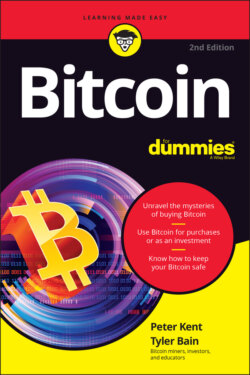Читать книгу Bitcoin For Dummies - Peter Kent - Страница 17
Understanding Bitcoin Units
ОглавлениеTo begin with, you need to understand that Bitcoin can be broken down and bought and sold in pieces. A Bitcoin is not like a gold coin; if you buy, for instance, a US$10 Liberty Gold Coin (for around $1,000, by the way), you’re buying the whole thing. You’re not buying half or a quarter.
But with Bitcoin, which can sell at $50,000, $60,000, or whatever per coin, most people can’t afford to buy in if they have to buy the entire thing. And in any case, there is no coin. It’s just an entry in the ledger.
So that entry in the ledger can say whatever we want it to say. It can say that you bought half a Bitcoin, or a tenth or hundredth, or a ten thousandth, all the way to a single one hundred millionth. That is, you can buy partial coins — fragments of a Bitcoin. Table 1-1 offers a quick look at Bitcoin units.
TABLE 1-1 Bitcoin Units
| Unit | Unit Name |
|---|---|
| 1; one | Bitcoin, BTC, B |
| 1/10; one tenth | deci-Bitcoin, dBTC |
| 1/1,000; one thousandth | milli-Bitcoin, millibit |
| 1/1,000,000; one millionth | micro-Bitcoin, μBTC, bit |
| 1/100,000,000; one hundred millionth | Satoshi, sat |
The table doesn’t show all the units, but these are the units you’re most likely to see and hear about. Because Bitcoins are divided into Satoshis — one hundred million Satoshis in each Bitcoin — you can divide a Bitcoin into tenths: deci-Bitcoin, centi-Bitcoin, milli-Bitcoin, micro-Bitcoin, and so on. (In fact, there is even a theoretical way to divide a Bitcoin down below the Satoshi level into milliSatoshi, using a special ancillary network called the Lightning Network, which we talk about in Chapter 4.)
Is there enough of the smallest Bitcoin unit to go around? Well, let’s take a look. There will only ever be 21 million Bitcoins; that means there will only ever be, at its maximum, 2,100,000,000,000,000 Satoshis in circulation.
Today, though, around 19 million Bitcoins are in circulation, and somewhere around 1,900,000,000,000,000 Satoshis.
With around eight billion folks living on the planet, today, about 237,500 Satoshis are in circulation per person (the number fluctuates; see the Satoshi clock at https://satoshisperperson.com/). Today, that's valued at around US$110.
To put this into perspective, roughly US$2,500 are in circulation (“M1” money supply) per person on the planet today (according to the Federal Reserve website at https://fred.stlouisfed.org/series/M1SL). That’s 250,000 cents per person, similar to the number of Satoshis.
All this means is that you don’t need a huge sum of money to get started with Bitcoin. You can buy small pieces of a Bitcoin, but beware the fees. Buying small quantities at a traditional exchange (see Chapter 3) can be expensive; in some cases, you’ll likely be paying more in fees than the price of the Bitcoin. Some exchange sites now have fee-free transactions. See, for instance, Strike (https://strike.me/en).
